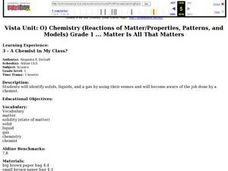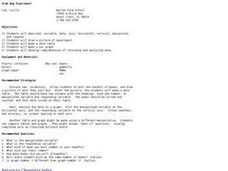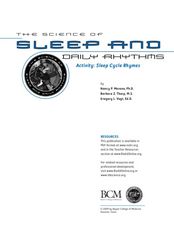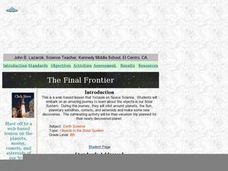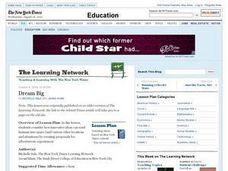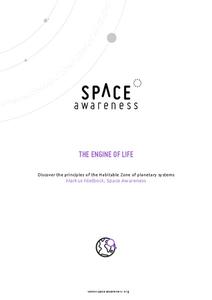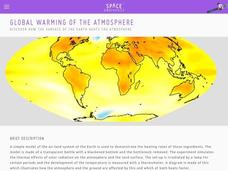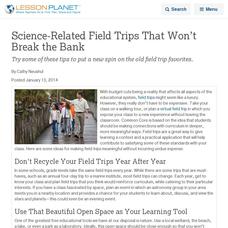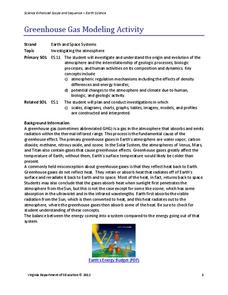Curated OER
Green Spaces
Learners map the green spaces around their school and predict the impact of population growth on green spaces in their region.
Curated OER
A Chemist in My Class?
First graders in kindergarten science class discuss matter. They make predictions and then identify mystery items in brown paper bags as either solid, liquid, or gas by using their senses. They discuss that a chemist is a scientist that...
Curated OER
What Wavelength Was That?
A combination of informative text, photos, and graphics comprise this sharp show on electromagnetic radiation. Some slides mention hands-on activities for demonstrating concepts, so if you want to include them you will need to figure out...
Curated OER
Grab Bag Experiment
Students analyze and record data. For this lesson about graphing and gathering data, students learn about the step of an experiment. Students learn new vocabulary, sort beans, record the data, and graph the data. Students add a variable...
Curated OER
The Science of Sleep and Daily Rhythms
Students observe their own daily rhythms by going to bed earlier and seeing what happens to their day afterwards. In this sleep lesson plan, students experiment with their own sleep cycles and answer questions about what happened because...
Curated OER
Physical Science: Bubble Prints
Pupils participate in a lab experiment involving soap bubbles and making bubble prints. They blow bubbles into the soap and add paint to make bubble prints. With extra time, they can play with a variety of bubble toys to see what bubbles...
Curated OER
Popcorn Science
Learners identify and apply the scientific method through an experiment with popcorn. Then they identify what independent, dependent, and control variables are and create a list of different variables that affect popcorn popping....
Curated OER
Science: Electric Fields from Point Charges
Students examine electric fields using viewers to discover the direction of positive charges and the location of the field's strength. They experiment with positive, negative, like and opposite charges. Students also describe how...
Curated OER
Science: Building an Electric Motor
Young scholars build their own electric motors and use them to conduct experiments. Following a step-by-step procedure, they make wire coils by wrapping wire around disc magnets and complete the process with clay, paper clips, alligator...
Curated OER
Planets in Our Solar System
Second graders research climate and landforms on nine planets in our solar system, choose one planet to visit, gather information about their chosen planet's climate and landforms, and "invent" space suit that would enable them to...
Curated OER
Dream Big
Students discuss the success of privately built and flown space crafts by reading and discussing a news article. They develop adventure trip proposals to present to Sir Richard Branson. Students write essays reflecting on the importance...
Curated OER
Inventors and Inventions 2:Air and Space
Students fly their own paper airplanes. In this flight lesson, students create paper airplanes and see whose plane will fly the farthest. They discuss what factors affect the flight and attempt to create a plane that will go farther.
Curated OER
Searching for Meteorites
Students examine meteorites and attempt to recover meteorite fragments. In this space lesson students complete a demonstration on the impact of a meteorite using water balloons and make experimental predictions.
Curated OER
The Space Shuttle and the Future
In this space shuttle worksheet, students review the different facts associated with the space shuttle and the space station. This worksheet has 23 true or false questions.
Space Awareness
Oceans as a Heat Reservoir
Oceans absorb half of the carbon dioxide and 80 percent of the greenhouse gases released into the atmosphere. Scholars learn how and why the oceans store heat more effectively than land and how they help mitigate global warming. Pupils...
Curated OER
Get the Picture!
Astronomers practice downloading data from a high-energy satellite and translate the data into colored or shaded pixels. As a hands-on activity, they use pennies to simulate high-energy satellite data and they convert their penny...
NASA
NASA: Moving Cargo
How does NASA transport people and cargo to planets? The five-lesson unit breaks down the transportation system that scientists use to transport cargo to space. Pairs team up in order to devise a transportation system that will...
Space Awareness
The Engine of Life
There is a specific zone, or distance from a star, that a planet must be in order to have water in a liquid form. The activity demonstrates how flux density depends on its distance from the source. A photovoltaic cell gets power to...
Inside Mathematics
Winning Spinners
Winning a spin game is random chance, right? Pupils create a table to determine the sample space of spinning two spinners. Individuals determine the probability of winning a game and then modify the spinners to increase the probability...
Space Awareness
Global Warming of the Atmosphere
Scientists know the amount of carbon dioxide in the atmosphere today is higher than at any point in the last 800,000 years. Scholars learn about the amount of thermic radiation absorbed by air and what happens to the rest of the...
NASA
Engineering Design for Human Exploration
What would it take to live on the lunar surface? Small groups build model rockets in order to simulate launching a habitat into space and rebuilding it. Divide the class into groups to design and build a model of a lunar habitat. The...
Curated OER
Science-Related Field Trips That Won’t Break the Bank
Try some of these tips to put a new spin on the old field trip favorites.
Teach Engineering
Strong-Arm Tactics
Experience collecting rock samples using a robotic arm with an activity that has pairs work together to operate a robotic arm. One pupil serves as the eyes and the other operates the controller. The objective is to be the fastest pair to...
Virginia Department of Education
Greenhouse Gas Modeling Activity
Why are greenhouse gases called greenhouse gases? Young Earth scientists learn about greenhouse gases though experimentation in the second installment of a 3-part series. They use lamps to model radiant energy as well...



